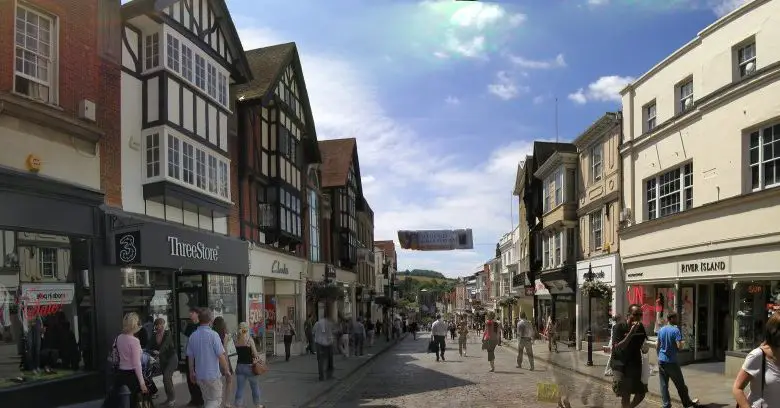
Inaccessible high street shops: retailers listen up!
Trailblazers recently launched a report and campaign to make our inaccessible high streets better. Aimed at getting the retailers to listen up and make changes for disabled people – who have the spending power of around £80 billion – Fleur Perry explains what’s needed and how you can make a difference.
Back in June I attended an All Party Parliamentary Group on the accessibility of local high streets. As an ordinary member of the public, attending a meeting inside the House of Commons was a fantastic opportunity, and though the invited retail representatives chose not to join us, the discussion proved highly informative.
There is a robust legal framework already in place to ensure retailers provide all customers with the same level of service. Businesses are expected to anticipate the needs of their customers, including those with disabilities, and make reasonable adjustments to accommodate them.
However, this legislation is not actively enforced and often misunderstood. The term ‘reasonable adjustments’ doesn’t mean ‘adjustments that would suit most customers reasonably well,’ but ‘adjustments that the business could reasonably be expected to make.’
Large, nationwide businesses have the necessary information and financial resources to make a variety of adjustments, whereas small, independent retailers may not be able to go to such lengths. In theory, every high street should be largely accessible, with just a few exceptions. In practice, it’s a very different story.
As a lifelong wheelchair user, I’m very accustomed to navigating labyrinthine shop layouts, nipping in and out of a shop as quickly as I can because I know I get in everyone’s way, and leaving certain shops vowing to never return.
It’s embarrassing when you have to ask half a dozen people to move just to get to the checkout, humiliating when you have to wait outside (in the rain) and frankly torturous when you can see the perfect pair of shoes but just can’t find a way to them.
I choose where I buy clothes and where I eat out almost solely on the basis of how accessible the location is to me. The simple fact of the matter is this: if I can’t easily get in and around your shop floor, I will take my business elsewhere.
Statistics suggest 3% of the population use a wheelchair, meaning there may be about 6,000 wheelchair users in my town. Legal obligations aside, can any business afford to turn away this many customers? It may also be relevant at this point to mention that the ‘purple pound’ – the combined spending power of people with disabilities – has been estimated to be around £80 billion.
Interestingly, I find that the independent retailers in my local area often are more accessible than the big names. Their passion and determination is often self-evident in their business practices and their attitudes towards their customers. Even when the shop is so small that there’s only one member of staff, that member of staff will go above and beyond to help in any way they can. Some larger retailers could learn a lot from their ethos.
So retailers, listen up: here are mine, and many other people’s, BIG pet hates…
Racks and rails spaced too close together
Precision driving is required to get around so many shops, it’s like a Top Gear driving challenge – in Jeremy Clarkson’s voice: “Some say she loves shopping, and that she once visited every cafe in town in a single afternoon. All we know is, she’s the Stig’s disabled cousin.” However, 2 inches of understeer or oversteer and it turns into the Mall scene from the Blues Brothers.
Random stuff in the way
Step-stools, shop trolleys or boxes left unattended on the shop floor are tripping hazards for everyone, and roadblocks for me.
Breakable objects on low shelves or near the edges of tables
There are few more nerve-racking experiences than driving a wheelchair around a kitchenware department, trying not to be the proverbial bull in the china shop.
Misuse of accessible facilities
A disabled toilet or changing room being used as a storage area is as useful as an umbrella with holes in it. The same applies if nobody knows where the key is kept or if lifts, induction loops, etc are not kept in good working order.
Does this sound like your last shopping expedition? There are things we can all do to change this, though it will take time. So make your voice heard and make a difference by:
- Talking to the shop staff – explain the difficulties caused and what they could do to help.
- Talk to the manager – ask about the company’s access polices. Show the manager the problem area and try to sound disappointed, not angry.
- Write a letter to the company’s headquarters – tell them what, where and when and remind them of their legal obligation to make reasonable adjustments.
- Tweet it – we’d love to hear your thoughts on the accessibility of our high streets and how to improve it
Read Trailblazer’s full report on inaccessible high streets, and find out how you can make a difference.
By Fleur Perry
Check out…
• 5 reasons why disabled people make awesome BFFs!
• New York Fashion Week: the first runway model in a wheelchair
• Disability and sex: let’s be frank about sex toys
Join in the latest hot disability debates by messaging us on Facebook, tweeting us @DHorizons, emailing us at editor@disabilityhorizons.com or leaving your comments below.